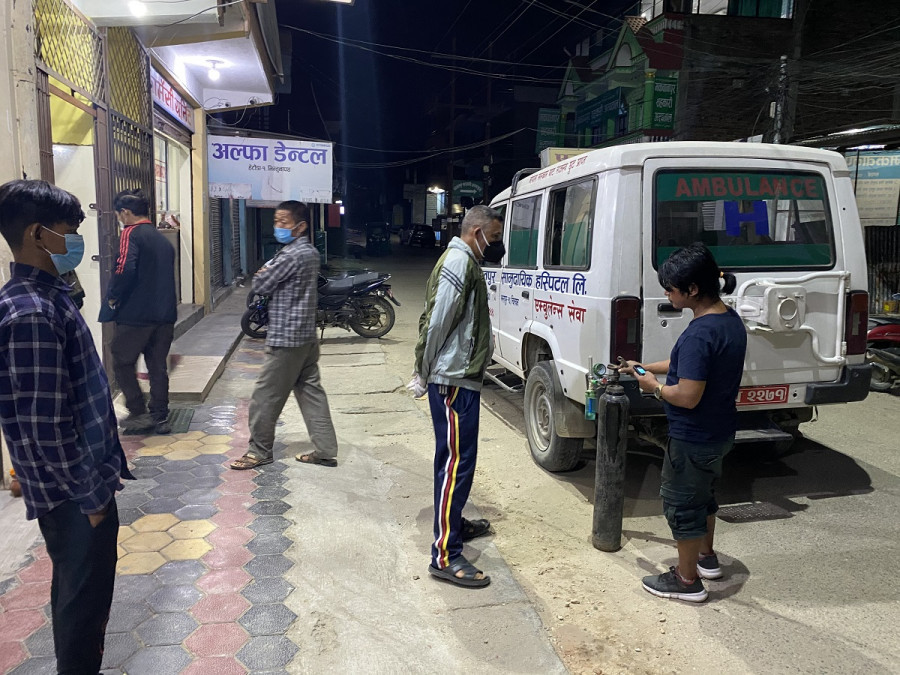Health
Authorities told to keep ambulances on standby as Covid-19 cases swell
The Health Ministry had recently called a meeting of the agencies concerned to discuss the preparations and alert them about the possible scenario of the coming days.
Arjun Poudel
Amid a spike in new cases of Covid-19 throughout the country, the Ministry of Health and Population has directed agencies concerned to keep 20 ambulances on standby for infected patients in the Kathmandu Valley.
The directive comes after new estimates showed that the number of new cases could increase more than two-fold than the peak time last year. The ministry has estimated that more than 300,000 people will be infected by July 15 by the regular variant of the coronavirus, the one which was responsible for the outbreak last year.
‘We have been asked to keep 15 to 20 ambulances on standby to carry infected patients to the hospitals,” Amit Joshi, the chief executive officer at the Nepal Ambulance Service, told the Post. “We are working to arrange the ambulances.”
Currently, the Nepal Ambulance Service is operating 11 ambulances and five of them are designated to carry infected patients.
The Health Ministry had recently called a meeting of the agencies concerned to discuss the preparations and alert them about the possible scenario of the coming days.
Joshi informed that the ministry has also agreed to let his organisation use the 27 ambulances currently operating in Kathmandu district, and 17 each in Bhaktapur and Lalitpur districts.
Likewise, the National Trauma Center has also allowed the Nepal Ambulance Service to run two of its ambulances.
“Apart from those, they have agreed to operate six more ambulances that the ministry is receiving in the near future from 102 [emergency phone number],” he added.
Last year infected people had to wait for up to 24 hours for ambulances, due to a shortage of ambulances. At present, infected people are seeking the service only if they become serious or suffer breathing difficulties.
“Now people have gotten used to or are less fearful of the infection,” added Joshi. “They might have used other vehicles including public vehicles to visit the hospitals.”
Officials have also recommended arranging sufficient numbers of personal protective equipment, face masks, face shields, globes, shoe covers and others, which could become scarce if cases rise dramatically.
“Each day 11,000 new cases will be detected if we do not follow safety measures, continue the gatherings and ignore the risks,” Dr Krishna Prasad Paudel, director at the Epidemiology and Disease Control Division, said. “The number of cases could be more than our estimation, as the new variant of virus is more infectious and fast spreading.”
The fast-spreading UK variant of the coronavirus, known as B.1.1.7, has been found responsible for the recent surge of infections in Nepal.
Nepal recorded 2,351 infections and 10 deaths in 24 hours, according to the figures released by the Health Ministry on Wednesday. This is the first time since November 19 last year that the number of cases crossed the 2,000 mark.
Of the total infected, the Kathmandu Valley recorded 1,051 cases—786 in Kathmandu, 181 in Lalitpur and 84 in Bhaktapur.
Many health facilities in the Kathmandu Valley are currently occupied by seriously infected people. This, doctors say, is because most people are seeking treatment only after their conditions deteriorate.
With new cases on the rise, the government on Monday issued various restrictions in order to contain the spread of the virus.
Public health experts have asked the authorities concerned to start case management and preparation for the worst case scenerio. They said that the authorities should start case management— ensure oxygen supply down to the health post level, make contact tracing effective and increase testing.
“Keeping ambulances on standby is one among various measures required to respond to the growing cases,” Dr Basudev Pandey, former director at the Epidemiology and Disease Control Division, told the Post. “Officials should also start working to increase bed numbers and oxygen supply, set up holding centers and quarantine facilities on a war footing. It will be too late if we wait for the health facilities to get overwhelmed.”




 8.12°C Kathmandu
8.12°C Kathmandu














